The House Armed Services tactical air and land forces subcommittee approved an Air Force plan to cut 42 A-10s and 57 F-15C/Ds in fiscal 2024.
The subcommittee’s markup of the 2024 National Defense Authorization bill, unveiled on June 12, would lower the minimum inventory requirements for A-10 and F-15C/D fighters as requested by the Air Force in the President’s budget request earlier this year.
The full committee meets June 23 to vote on amendments and complete its version of the annual defense authorization, after which the measure must clear the full House. When the Senate passes its version of the bill, the two versions must be reconciled in a conference process that can make further changes. But getting the Air Force plan through the subcommittee markup is a key first step.
The tactical air and land forces subcommittee markup would surrender those A-10s under a condition, however. If approved, the Secretary of the Air Force would have to devise a plan to ensure air crews maintain proficiency in close air support and would prohibit additional A-10 retirements until that plan is delivered to Congress.
Any agreement to retire A-10 marks a major victory for the Air Force, which has argued for years that the jets are vulnerable to modern integrated air defenses. Congress approved retiring 21 A-10s last year, however, and the first of those went to the Boneyard only this past April. Air Force Chief of Staff Gen. Charles Q. Brown Jr. has said the Air Force should retire the entire A-10 fleet by the end of this decade.
F-15C/D divestment has been less contentious, but cutting 57 in a single year would mean retiring more than a quarter of the 200 or so C/D models remaining, most of which are in the Air National Guard.
The fighters are among 310 older aircraft the Air Force wants to retire in 2024, among the biggest yearly reductions in memory. The Air Force says cutting those aircraft will free up funds for new F-35 and Next Generation Air Dominance fighter development and purchases. But critics have countered that the Air Force should have sought additional funds, on top of its budget request, rather than give up so many aircraft at once.
The subcommittee’s markup addresses those programs as well. It would require the F-35 Joint Program Office to break out its Tech Refresh 3 and Block 4 upgrades into a subprogram, answering a recommendation made by the Government Accountability Office in a recent report.
The bill also includes a provision that would extend oversight of both the Air Force’s and the Navy’s Next Generation Air Dominance and Collaborative Combat Aircraft programs. The markup seeks annual progress reports on development and technology maturation, and requires Pentagon officials to establish key performance indicators “regarding flyaway unit cost, gross/weapon system unit cost, aircraft cost-per-tail-per-year, and aircraft cost-per-flight-hour.”
The Air Force’s NGAD program, shrouded in secrecy for years, is only now beginning to come to light. Air Force Secretary Frank Kendall has said each sixth-generation aircraft will likely cost “multiple hundreds of millions of dollars” per tail, which would make it the most expensive fighter ever. The service started the competition earlier this year.
